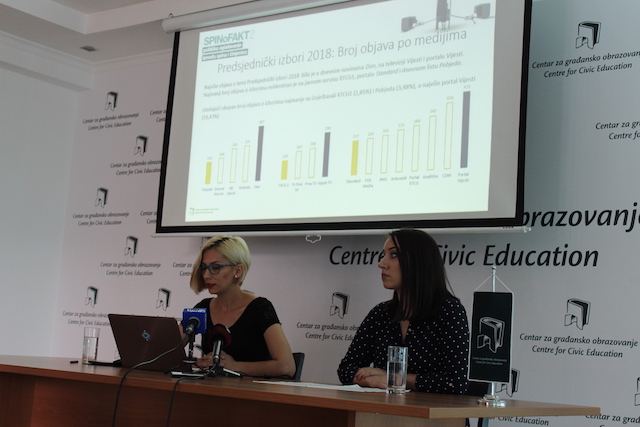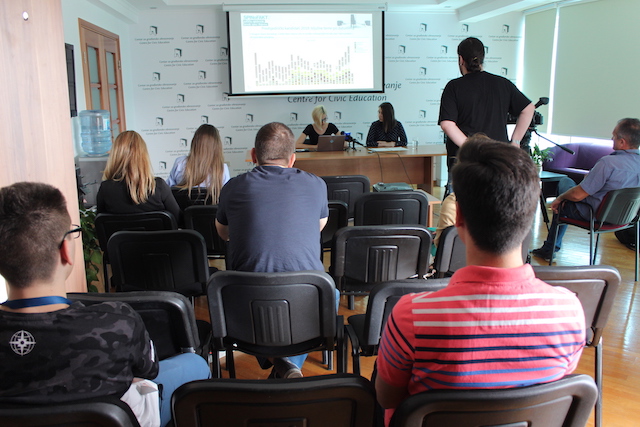Centre for Civic Education (CCE) has today, within the project ’SPINoFACT 2 – political advertising between spin and facts’, presented final findings of monitoring of media campaign for presidential election which have been conducted on 15 April 2018.
Bojana Knezevic, project assistant in the CCE, emphasized that monitoring was done from 15 March to 15 April (until 20h) and reminded that first findings of monitoring were presented in March, upon expiration of deadline for submission of candidacies for President of Montenegro. ’As earlier, monitoring itself has encompassed qualitative and quantitative research. Overall number of media releases of candidates as per type of media and per candidates, representation of candidates in media, planned and non-planned releases, tone of campaign of candidates, topics which were predominant in campaign, mutual attacks and critics of presidential candidates were monitored’, said she. In addition, she clarified that research included 17 printed and electronic media, televisions – RTCG1, Vijesti, PinkM and Prva; daily newspapers – Vijesti, Dan, Pobjeda, Dnevne novine and Sloboda, as well as portals – Cafe del Montenegro (CdM), Analitika, Vijesti, RTCG, Antena M, Standard, FOS Media and In4S.
Zeljka Cetkovic, programme associate in the CCE, presented in detail results of monitoring of media campaign and on this occasion highlighted that ‘Overall number of releases for topic ‘Presidential elections 2018’ for all three types of media (televisions, printed media, portals) was 4534, of which the most on portals 55,12%, followed by printed media 26,91% and at the end in electronic media 17,98%. Furthermore, it is worth emphasizing that larger representation of negative in relation to positive campaign was noted.’
Data of monitoring of media campaign indicate in overall 2 091 563 mm2 is related to coverage of this topic in newspapers, and 68 923 seconds on TV stations. This topic was dedicated the most space by daily newspaper Dan (in average 1379 mm2 as per article) and TV Pink M (in average 124 seconds as per release). The most releases on topic Presidential elections 2018 were in daily newspaper Dan (387), in television Vijesti (299) and portal Vijesti (473). The least number of releases on elections was registered on public service RTCG1 – 129, portal Standard – 227 and daily newspaper Pobjeda – 158. Assessing the total number of releases on elections, the least reports were at the RTCG1 (2,58%) and in Pobjeda (3,48%), and the most at the portal Vijesti (10,43%).
‘Even as much as 43% releases were dominantly related to election procedures, while on the other hand, only economic issues and issue of corruption and criminal have exceeded 10%. Social and identity issues are represented in somewhat larger percentage in sporadic mentioning’, stated Cetkovic.
Presidential candidate Milo Djukanovic stood out as per number of releases, since he was mentioned in the content of 2744 releases, whereby monitoring for Djukanovic started from the day of his official candidacy 19 i.e. 20 March 2018. Next are Mladen Bojanic with 1830, Draginja Vuksanovic with 1001, Marko Milacic with 730, Vasilije Milickovic with 475, Dobrilo Dedeic with 327 and Hazbija Kalac with 226.
‘In the observed period, Mladen Bojanic has had the most planned appearances, his own and party ones (971), on portals CdM, In4S and Vijesti, and the least at TVCG1. Presidential candidate Milo Djukanovic has been mentioned the most by other subjects at portal Vijesti and in daily newspaper Dan, and the least at TVCG1 and TV Prva. As per planned media appearances in promotion of one’s own election programme (in the overall release or larger part), the most active was presidential candidate Milo Djukanovic (39%), while the most active in criticism was Mladen Bojanic (44%)’, said Cetkovic.
In the second part of campaign, close to the election day, there were more talks about corruption/criminal, as well as economic and identity issues. Thereby, the presidential candidates themselves have put focus predominantly on economy.
‘Individually, Milo Djukanovic has spoken the most about economy, identity issues and European integration, Mladen Bojanic about criminal and corruption, economy and regional cooperation, Draginja Vuksanovic about economy, criminal and corruption, and social issues, etc. Identity issues were potentiated solely by Milo Djukanovic and Dobrilo Dedeic, while NATO only by Marko Milacic’, specified Cetkovic.
She also emphasized that ‘candidates have almost not been talking about presidential jurisdiction prescribed by Article 95 of the Constitution of Montenegro’.
Cetkovic emphasized that ‘analysis of tone and the overall picture point out that the most negative media releases were about presidential candidate Milo Djukanovic i.e. 49,6%, while he had 31,3% positive ones. Presidential candidate Mladen Bojanic had 42,7% positive media mentioning, and 18,08% negative ones. Neutral tone dominated with other candidates, whereby presidential candidate Draginja Vuksanovic had double more positive than negative releases.’
When it comes to quantitative representation, individually, as per printed media, the most space (mm2) for planned appearances has given daily newspaper Sloboda to candidate Mladen Bojanic – 142 264 mm2, Dnevne novine to candidate Milo Djukanovic – 123 607 mm2 as well as Pobjeda with 89 587 mm2, while candidate Draginja Vuksanovic has gained the most space in Dan – 52 058 mm2. Individually, the most seconds for planned appearances gained Milo Djukanovic on TV Pink M – 9 570 seconds, and Mladen Bojanic on TV Vijesti – 4 684 seconds. The largest percentage of planned appearances Mladen Bojanic has had on TV Vijesti – 62%, Milo Djukanovic on TV Pink M – 48%, while Draginja Vuksanovic has equally been represented on TV Vijesti and RTCG1 – 47%, whereby it should be noted that Djukanovic has not been coming to talk shows organised by public service RTCG and TV Vijesti.
All presidential candidates used the opportunity to present themselves in out-informative shows on public service, and only Djukanovic had planned appearances in out-informative shows on TV Pink M and TV Prva.
Bojana Knežević also presented the results of monitoring of political marketing. ‘Vasilije Milickovic and Marko Milacic started advertising the first and they did not have significant oscillations during the observed period. The presidential candidate Milo Djukanovic started advertising on 28 March and stood out significantly with the number of advertising clips/reports until the very end of the campaign.’ Furthermore, she pointed out the data that ‘presidential candidate Mladen Bojanic had the most advertisements in printed media (Vijesti – 12, Sloboda – 10 and Dan – 13), while presidential candidate Milo Djukanovic presented himself in Dnevne novine (11) and Pobjeda (18). Draginja Vuksanović, Hazbija Kalač and Vasilija Miličković did not advertise in print media.’
‘In 30 election days, citizens could see as many as 28,37 hours of presentation of presidential candidates through political-propaganda TV-clips, as well as reports/transmissions from promotional gatherings. Presidential candidates exercised their right to free of charge presentation on TVCG, where as many as 57% of clips/reports were broadcasted, followed by TV Pink M – 26,62% and TV Prva 14,98% while TV Vijesti broadcasted merely 1,5% of clips/reports from presidential candidates’, Knezevic underlined.
She also pointed out that ‘out of a total of 16,15 hours provided for free-of-charge political marketing (TVCG1 and TVCG2), Vasilije Milickovic used the most, as much as quarter of total seconds, and at least Mladen Bojanic – 8%. This time includes also political-propaganda TV-clips and reports from promotional meetings.’
On the other hand, presidential candidate Mladen Bojanic advertised himself on TV Prva, TV Pink M and TV Vijesti in a total duration of 1 254 seconds (20 minutes and 9 seconds), while Milo Djukanovic bought even 33 times more seconds on TV PinkM and TV Prva (41 894 seconds – 698 minutes and 23 seconds)’, Knezevic said.
During the election silence, the media placed 165 releases of which 126 were about election procedures. In television content, 24 releases were found, 40 in printed media, and 101 releases on the portals. ‘Accordingly, the violation of election silence has been identified in printed media in the following: ND Vijesti, Sloboda, Dnevne novine, as well as on the Vijesti and IN4S portal’, Cetkovic pointed out.
The project ‘SPINoFACT 2 – Political advertising between spin and facts’ aims to contribute to the promotion of good practices and improvement of the legislative framework when it comes to political advertising and presentation of election offers in the media in Montenegro. In addition, the objective of the project is to improve cooperation between media, relevant institutions, political parties and non-governmental organisations, and to raise public awareness of importance of quality and objective information to citizens during election campaigns. Arhimed company has done the expertise part of the research for the needs of the project. CCE has with Arhimed, with the support of the Kingdom of the Netherlands, already been monitoring the media coverage and representation of election actors through pilot project with the same name, and on the example of the local elections in Petnjica, Mojkovac and Cetinje which were held at the end of November 2017.
Milos Knezevic, PR/programme associate



